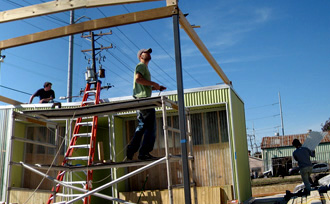$1 Million for Architecture's Community Work
The Tulane School of Architecture, which has linked its curriculum to community needs in new and profound ways since Hurricane Katrina, has received a $1 million grant from an anonymous donor to continue this effort.

In a community project through Tulane City Center, architecture students construct a shade unit for the Hollygrove Market and Farm in New Orleans. (Photo by Emilie Taylor)
The grant will benefit the Tulane City Center, home to many of the School of Architecture's applied research and outreach programs.
These programs include university/community design partnerships, which bring together students, faculty and community partners to help revitalize neighborhoods; GREENbuild, through which architecture students design and build sustainable homes; and the CITYbuild Consortium of Schools, which coordinates efforts of architectural students around the country to aid New Orleans' recovery.
"This grant will strengthen and expand the Tulane City Center's work, by enabling us to engage a wider array of local organizations who know the needs of their communities better than anyone," says Scott Bernhard, the Jean and Saul A. Mintz Associate Professor of Architecture and director of the Tulane City Center.

The completed project in Hollygrove includes modular units for work and storage space. (Photo by Will Crocker)
"By partnering with these neighborhood groups we can help bring about an affordable, sustainable and innovative reconstruction of New Orleans and the region," Bernhard says.
The grant will be paid in yearly installments of $100,000 that will support one "design/build" project and one "visioning document" each year.
A visioning document is a booklet of plans and renderings for large, multi-phase projects that will help community members and potential donors understand the ultimate goals of the project.
"This is the first of what I hope will be many major gifts to the Tulane School of Architecture," says Kenneth Schwartz, dean of the School of Architecture. "Our success in connecting architectural education with community needs has distinguished our school on a national and international level since Hurricane Katrina. This is an effort that benefits our students and faculty as much as it does the community."
